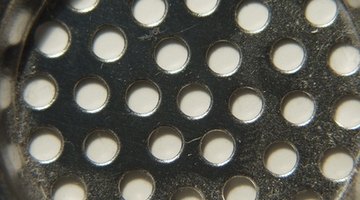Homemade Sieves
Sieves can be used to separate different substances from one another. You can make a homemade sieve from just about anything. Try old pastic containers, Styrofoam bowls or egg cartons. Consider the substances you're sifting when picking a material for your homemade sieve.

Sifting something heavy will require a sieve made out of substantial material, perhaps an old plastic container. For sifting something light, you might use an old egg carton. Try making a sieve out of a foil cooking pan for medium strength.
Things You Will Need
- Foil pans
- Pens
-
Place your fingers underneath the bottom of the foil pan in a small "V." Holding the pan up with your fingers will ensure that the foil doesn't rip as you make your homemade sieve.
-
Punch a hole through the "V" with a pen. The hole's width depends on what you want to sift. If sifting sand and water, make your holes fine with just the pen's tip. You can make larger holes by pushing the pen all the way through the foil.
-
Punch a second hole roughly 1/2-inch away from the first hole, again using your fingers in a "V" shape to support the bottom of the pan. Avoid punching the holes too close together because that could tear the foil.
-
Punch holes all the way around the bottom of the pan. Don't punch holes in the sides, because you'll want the foil to hold on to as you pour liquid into your homemade sieve.
-
Test your sieve. If sifting sand and water, pour the substance into the sieve. You can always start over, adjusting the size of your holes if not appropriate for your project.
Warning
Be careful not to punch your fingers with the pen. Push lightly against the foil at first to make sure the pen's tip will fall into the "V" and not into your finger.
The Drip Cap
- Sieves can be used to separate different substances from one another.
- Try old pastic containers, Styrofoam bowls or egg cartons.
- If sifting sand and water, make your holes fine with just the pen's tip.
Photo Credits
- sieb image by Fran Peterz from Fotolia.com
- sieb image by Fran Peterz from Fotolia.com
More Articles



